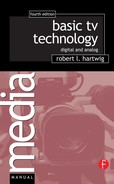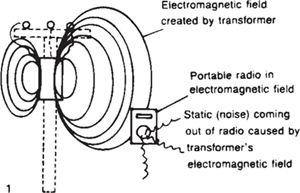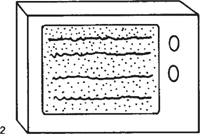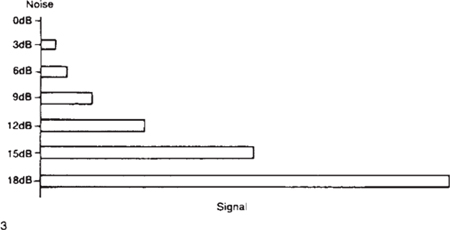Induction and noise are disruptions in an electrical circuit
Fields (Induction) and Noise
Fields (Induction)
Two other basic theories are necessary for understanding television equipment. The first of these is fields (induction). Any electrical circuit that has a changing flow of electrons will create an electromagnetic field around itself. For example, if you turned a flashlight on and off several times, the flow of electrons would be starting and stopping and a small electromagnetic field would be created. However, if you left the flashlight on, the flow of electrons would be continuous and unchanging and there would not be an electromagnetic field. Since the flashlight uses very small amounts of electricity, its field would be very small — almost unmeasurable. But a high-tension power line running cross-country has an extremely strong electromagnetic field. When another circuit is placed within this electromagnetic field, a signal from the more powerful circuit is forced, or coupled, into the weaker circuit. The signal may take the form of static, as when you try to play the AM radio in your car near high-power lines, or it may be actual information, as when you sometimes hear very weak background voices on the telephone.
Noise
Another thing that can create problems is noise. To see what noise looks like in video, unhook the antenna and/or cable from your TV. Turn your TV on. What you see is noise! If you happen to be near a transmitter and have your TV tuned to its channel, you'll also see some picture. This noise is obviously an undesirable feature. Too much of it and it interferes with the picture or signal. Inherent in every electrical circuit is a certain amount of this noise. If there is too much noise, then there is a problem. Certainly, if you want to watch TV, you don't want to see any noise.
Signal-to-Noise Ratio
You need to be able to measure the relationship between the strength of the signal and the amount of noise the circuitry creates. This measurement is called the signal-to-noise ratio. We use the decibel (dB) scale to measure this relationship. The dB scale is a logarithmic ratio. The signal-to-noise ratio is doubled for every 3-dB difference between the strength of the signal and the strength of the noise. For example, if the noise in our system is 0 dB and the signal is 3 dB, then the signal is twice as strong as the noise; if the signal is 6 dB, then it's four times as strong as the noise; if the signal is 9 dB, it's eight times as strong; 12 dB, 16 times as strong; 15 dB, 32 times as strong; and so on. In video, we like to have a signal-to-noise ratio of at least 60 dB.
2. Video noise
3. Signal-to-noise ratio. Comparison of the strength of the signal with the noise using the dB scale.
4. Minus and positive signal-to-noise ratios.




